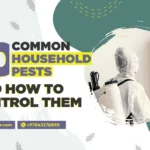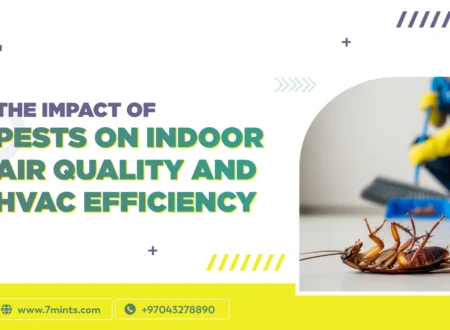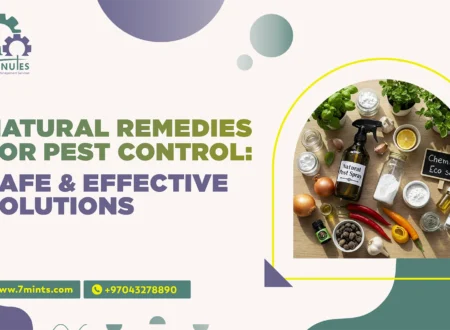Suddenly, summer arrives with its warmth and sunshine and makes all activities possible outdoors. In its wake come unwelcome guests that flourish in hot and humid weather. You will encounter these pests invading your home, gardens, and casual outdoor hangouts—creating discomfort while posing potential health risks. The focus of this blog is on summer pests in most cases and how to effectively manage them.
Common Summer Pests
Insects that bite, sting, or destroy gardens and houses are all common summer pests. Understanding these pests so that one can manage them is an important part of pest management.
1. Mosquitoes
Mosquitoes, perhaps the most famous summer pests, breed in stagnant water and feed off warm weather. Not only are their itchy bites bothersome, but they can also cause illnesses such as dengue fever, malaria, and West Nile virus. Mosquitoes find carbon dioxide and moisture attractive, hence being nuisances near homes with gardens or near water bodies. Their rapid reproduction means thousands can be born from just one small pool of water.
Management Recommendations:
Movement of Water in Standing Water: Regularly check your property for places where water will stand, such as birdbaths, pots for plants, and gutters. These should be emptied or blanketed so that mosquitoes cannot breed. Even very small amounts of standing water, like in bottle caps or a flower vase, are enough for mosquitoes to lay eggs! You also have to check lagoons for clogging and make sure water does not collect in these lagoons. Outdoor water features like ponds or fountains must be checked frequently to destroy mosquito breeding.
Install Screens: The most important thing to do is keep the mosquitoes out by installing screen doors and windows. Repair screens that have tears or holes in them so that they can do their job. Examine screens regularly and repair or replace them to counter the efforts of mosquitoes in locating entry points into your home. This is especially mandatory if your neighborhood has a high density of mosquitoes.
Use Natural Predators: Encourage natural predators like dragonflies or apply larvicides in water bodies for the mosquito control program. Dragonflies eat mosquitoes, and planting flowers that attract dragonflies can create an appealing environment for them. For instance, water lilies and other aquatic plants can encourage dragonflies to visit your garden, especially the ponds or water features.
Make Mosquito Traps: There are different types of mosquito traps available in the market that work with UV light or, in some cases, use the carbon dioxide they exhale, so they can capture mosquitoes through an attraction process. These help you to greatly reduce mosquito impact within your house.
2. Ants
Ants get more active during summer while searching for something to eat. The carpenter ants could destroy wood structures, while the fire ants would cause a painful sting. The main attraction for an ant is always sweet or sticky things, and they will rapidly invade your house if food is left outside. Their colonies can grow swiftly to the point that it becomes difficult to eradicate an established colony. Ants are very organized, and with different roles among their colonies, they become very interestingly adept at finding and exploiting food sources.
Management Measures:
Seal or Block Entry Points: Thoroughly examine your home for any cracks and crevices around windows, doors, and pipes. Formulate these openings with caulk or silicone and prevent them from being a route for ants to enter the house. Regular inspections are necessary, as ants can find new entry points quickly. Review in particular the areas around windowsills, door frames, and any gaps.
Store Foods: Keep all your food in sealed containers. Clean up crumbs and spills to eliminate extra food sources that will attract the ants. These foods should include pet foods and seeds for birds that should be kept in sealed bins. In addition, a well-maintained standard of kitchen cleanliness and surface cleaning after meals will keep ants at bay.
Maintain a Clean Yard: Regular raking of refuse and clutter removal will help keep your yard nature tidy. Mow the lawn regularly and pull out weeds as they might be a sanctuary for ants. A well-manicured lawn will reduce the chances of ants nesting close by. check out the latest blog post on 10 Common Household Pests and How to Control Them.
3. Flies:
The most common problems in summertime are flies, which are attracted either to spoiled organic materials or solid waste. They will annoy your food with the ability to infect it with different kinds of diseases. Houseflies and blowflies, for example, are very nasty because they lay their eggs on rubbish or in piles of compost, leading to a very rapid infestation. They are also a favorite because they can fly from one place to another in a very short time.
Management Tips:
Hygiene Maintenance: Check that all food is stored in closed containers, and spills should be cleaned without delay. Floors must be cleaned regularly, as crumbs and dust may attract cockroaches; cleaning underneath appliances and behind furniture must also be done since that is where crumbs and dust tend to accumulate.
Damp–Proof: Water from broken pipes should be checked for and repaired. Make sure your area receives enough ventilation. Run a dehumidifier in humid zones like basements or bathrooms. If during the daytime condensation is present on the windows and walls, then the area could be a sign of high humidity.
Cockroach Baits: When one considers baits for roaches, one reflects on all that these baits can do: they usually poison cockroaches when they return into their nests with the poison and kill others. Put the baits down where the roaches are found: under the sink, behind the appliances, and other such places. The baits must be explicitly labeled to indicate which kind of cockroaches are to be targeted.
Seal Entry Points: Check your house for any cracks and fractures because cockroaches can enter through the tiniest openings. Seal with caulk or silicone. Pay special attention to cracks or crevices around pipes, vents, and electric sockets.
Professional Help: If you have a heavy infestation of cockroaches, do not hesitate to call a pest control company. They know how to tackle situations with specialized equipment and treatments. Beyond that, they help in pinpointing entry points and suggest long-term measures to keep cockroaches out.
5. Stinging Insects (Bees, Wasps, Hornets)
Wasps and hornets love every kind of summer activity, from building nests to searching for food. They help with the process of pollination but will defend themselves and their nests when threatened. These social insects live in colonies and can be aggressive when provoked.
Management Tips:
Avoid Leaving Food Outdoors: Stinging insects like anything sweet. Whenever eating outside, do not leave uncovered sugary drinks or food. Instead, cover or dispose of them immediately to limit the attraction.
Constantly Check Your Property: Every so often, inspect your house for nests, especially under eaves, decks, and behind bushes, inside and outside. Finding nests at an early stage will help prevent them from growing into an infestation. One must also keep an eye out for an influx of flying insects in a given area, denoting activity.
Get Professionals: If a big nest is found, it is advisable to hire somebody for the safe removal of the same. While they are equipped with protective clothing and equipment to minimize the risk of being stung, they will also be able to ascertain what type of insect is involved and the best method available for its removal.
Forgoing Stings: When gardening or going exploring around areas where bees might want to build nests, wear long sleeves, gloves, and a veil to counter the threat of stings. Try to avoid using perfumes or colognes that would attract stinging insects.
Create Tick-Free Zones: You might want to make a tick-free zone within your yard areas by simply cleaning the leaf litter and putting down tick-killing granules. Such areas may prove especially helpful in and around the play areas or zones for pets.
7. Lawn Pests: Grubs, Chinch Bugs, Mole Crickets
Things like chinch bugs and Grubs feed off the roots or stems of the turf and leave patches of brown across your lawn. These pests weaken your turf, leading it to disease and damage. Most lawn pests can be detected but only after serious damage, making prevention essential.
Management Tips:
Water Thoroughly but Sparingly: It is not of great importance for your lawn to be watered much but rather deeply. In this way, roots are facilitated to grow deep, thus leading to pest resistance. Shallow watering frequently causes soil to retain moisture near the surface, drawing pest activity.
Nematodes or Insecticides: Nematodes are microscopic worms that attack and kill grubs. It is equally effective to apply any insecticides labeled for lawn use on pests. Always, Read and follow the instructions on the product for safety and effectiveness. It is also important to apply these products at the right time.
Soil Aeration: Aerating your lawn will improve the health of your soil and will aid in reducing pest populations through better drainage and air circulation. This will also alleviate soil compaction, which makes your lawn vulnerable to pest damage.
Good Lawn Hygiene Maintenance: Regular mowing of the lawn and weed removal would deprive the pests of shelter. It’s best to mow the lawn with the collection bag’s attachment so that clippings do not become available for pests to feed on. A well-maintained lawn would inhibit pest infestation.
8. Garden Pests: Aphids, Tomato Hornworms, Slugs.
Summer gardens will be host to a variety of pests that feast on vegetables, fruits, and ornamental plants. The resulting reduction in crop yield and poor plant health is significant. Most of the garden pests are attracted to certain plants, hence the need to keep an eye on your garden for any early signs of infestation.
Management Intelligence:
Utilize Row Covers: Row covers are thin fabrics that shield plants from easy access of flying insect pests like aphids. Light and moisture can pass through row covers, thus keeping the pest out. They prove very useful to young plants and sensitive crops for their utmost covering.
Handpick the Larger Pests: Large species like the hornworm and the slug might be picked off from plants. Peruse your plants by night for the time when slugs become most active. Offer good protection by using rubber gloves to avoid some slime they produce while handling slugs.
Use Neem Oil or Insecticidal Soap: These organic insecticides have been found to be effective for soft-bodied insects like aphids when applied directly to the infested areas, without causing damage to harmless living beings. Always read the label on the product and do a small patch test beforehand.
Encourage Natural Predators: Beneficial insects like ladybugs or lacewings can feed on the excess pests that have penetrated into your garden. For example, marigolds and sunflowers can attract many beneficial insects: Plant these wonderful flowers in your garden to attract beneficial insects and create an ecosystem in your garden.
Use Physical Barriers: Copper tape physically stops slugs from crawling. Just hold it around your plant pots or raised beds. Slugs prefer not to crawl over copper, which produces a barrier. Crushed eggshells or sharp gravel surrounding plants can work to deter slugs.
Conclusion
The summertime holds the glorious essence of sunshine, outdoor activities, and a counter underpinned solely by pest activity. Knowing which pests determine activity during this period and how to control them will ensure a pest-free summer while protecting your house and garden and health.
Use preventive measures to keep those pesky party crashers away, like getting rid of standing water to curb mosquito activity or sealing up cracks to ensure ants don’t take hold in the kitchen. So keep on guard, and have the best fun in the summer! contact us as Pest management combines vigilant action, timely intervention, and regular maintenance for an effective strategy.










1 Comment
Comments are closed.